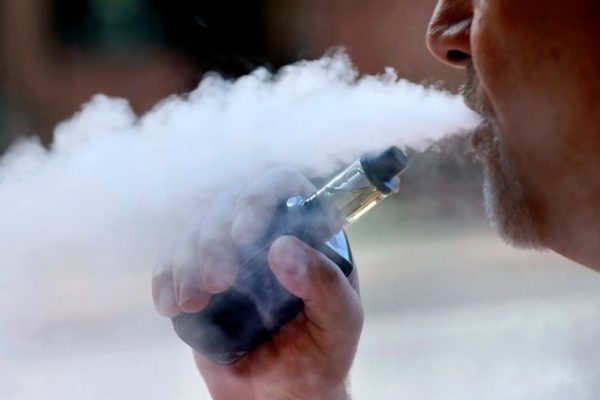
02 Oct To Your Health: Vaping Illness & Death
Dr. Alan Safdi, a world-renowned internist and gastroenterologist with encyclopedic knowledge of mind-body wellness and preventative medicine, posts on Telluride Inside… and Out under the banner of “To Your Health.” His blogs feature the most current information in his field: health, wellness and longevity.
This winter, Dr. Alan returns with his popular Live Longer Retreat wellness intensives, which repeat in the summer. For further information, email telluridecme@gmail.com. or go to Safdi’s Telluride Longevity Institute website.
This week, Dr. Alan takes a close look at vaping-related illnesses and deaths.

An outbreak of vaping-related illness in the United States—especially among young adults and teenagers—has evoked deep concern among physicians and others in the medical community, with some public health officials declaring the epidemic a national crisis.
Given the dark headlines, here is what everyone should know.
The FDA and CDC, as well as local and state health departments, are currently investigating a spate of recent lung injuries and deaths among Americans who vape.
As of this writing, there have been 11 deaths due to vaping and 530 reported cases of vaping-related lung injuries in the United States, according to the CDC—with “hundreds” of new cases on deck.
Of the 373 cases examined by the FDA so far, 72% occurred in males; 67% occurred in people aged 18-34 years; and 16% occurred in people aged 18 and younger. Most individuals with vaping-related illness reported a history of vaping tetrahydrocannabinol (THC) products. However, some reported previous use of e-cigarette products containing nicotine only.
Investigations continue to determine the cause of the recent cluster of severe respiratory illnesses among e-cigarette users.
Background:
Electronic cigarettes go by many names, including e-cigarettes, vapes, vape pens, e-hookahs, and electronic nicotine delivery systems (ENDS).
Vapes heat up a liquid to an aerosol form, which is then inhaled into the lungs. This liquid consists of a variety of substances, additives, and active ingredients, including aldehydes, alcohol, nicotine, THC, and cannabinoid oils. Many substances found in vape liquid could contribute to the illness — but no single, stand-out cause has yet been found.
In addition, the coils used in a vape pen or e-cigarette device could easily release harmful metals—such as manganese and zinc—into the inhaled aerosol when heated.
Symptoms:
Very little research has been published on the clinical effects of vaping, however, in July 2019 the Wisconsin Department of Health Services and the Illinois Department of Public Health partnered in an investigation, publishing their results as a preliminary report in The New England Journal of Medicine.
“Although the definitive cause of this cluster remains unknown, the severity of the illness and the recent increase in the incidence of this clinical syndrome indicates that these cases represent a new or newly recognized and worrisome cluster of pulmonary disease related to vaping,” wrote the investigators, led by Jennifer E. Layden, MD, PhD, chief medical officer and state epidemiologist, Illinois Department of Public Health.
The study included 53 people (83% men; median age: 19 years) who vaped within 90 days prior to symptom onset. In total, 100% of participants experienced generalized symptoms; 98% exhibited respiratory symptoms; and 81% experienced gastrointestinal symptoms. Moreover, all participants exhibited bilateral infiltrates on imaging. Of note, infiltrates and lack of pulmonary infection were case definitions for the study. In total, 94% of the study participants required hospitalization, with 32% requiring intubation and ventilation. One person died.
“Although the variety of imaging patterns suggests different mechanisms of injury, and more patterns will probably be reported, most of the patterns have basilar-predominant consolidation and ground-glass opacity, often with areas of lobular or subpleural sparing. Rapidly developing acute lung injuries (eg, acute eosinophilic pneumonia and diffuse alveolar damage) are associated with inhalational injuries and have overlapping pathological and imaging findings, and they have been reported to occur with vaping,” wrote Travis. S. Henry, MD, University of California, San Francisco, San Francisco, CA, and colleagues in an accompanying commentary.
Pneumonia-related damage:
If you have been following the news, you have likely heard that lipoid pneumonia is associated with vaping.
Lipoid pneumonia is an inflammatory process secondary to lipids within the alveoli and results from the inhalation of hydrocarbons and oils found in vaping liquid. Indeed, lipoid pneumonia has been detected in some of these cases, with evidence of lipid-laden alveolar macrophages obtained by bronchoalveolar lavage (BAL) and lipid-staining. Notably, attenuation of the lung, a pathognomonic imaging finding for lipoid pneumonia, has not been observed.
Other patterns seen on imaging in patients who previously vaped correspond with acute eosinophilic pneumonia, organizing pneumonia, and diffuse alveolar damage, as well as variegated patterns. In some clinico-pathologic investigations, hypersensitivity, giant-cell interstitial pneumonia, and diffuse alveolar hemorrhage were identified. Importantly, no specific antigen leading to hypersensitivity pneumonia has yet been elucidated in those who vape.
According to Dr. Layden and coauthors:
“Since no single product or substance has been associated with the illness, persons should consider not using e-cigarettes while this investigation is ongoing, especially those purchased from sources other than authorized retailers (eg, e-cigarette products with THC) and those modified in a manner not intended by the manufacturer. Adult smokers who are attempting to quit should consult with their health care provider and use proven treatments.”
Dr. Layden and fellow researchers also warn that vaping products should never be used by pregnant women, young adults, and nonsmokers.
Dr. Alan Safdi, more:

Dr. Alan Safdi is board-certified in Internal Medicine and in Gastroenterology and is a Fellow of the American College of Gastroenterology. A proven leader in the healthcare arena, he has been featured on the national program, “Medical Crossfire” and authored or co-authored numerous medical articles and abstracts. Safdi has been involved in grant-based and clinical research for 30+ years and is passionate about disease prevention and wellness, not just fixing what has gone wrong. He is an international lecturer on the subjects of wellness, nutrition and gastroenterology.
And back by popular demand, this summer, in partnership with the Peaks’ Spa, Dr. Safdi returns with his three, week-long wellness intensives titled Live Longer Retreat.
Again, using an evidence-based, scientific approach to health and longevity and featuring an experienced staff of medical professionals, personal trainers, Pilates and yoga instructors, dietitians, and chefs, the focus is on your unique wellness profile. Each Live Longer Retreat is one-of-kind in the U.S. Those intensives, limited to only 10 – 15 participants, will include personal consultations, hiking, spinning, yoga, Pilates, talks and demonstrations related to nutrition, cooking classes, and more.
Go here to read a review of the experience by one very satisfied participant.
Feel free to sign up now to participate in a Live Longer Retreat – or call 1-877-448-5416 for further information.


Sorry, the comment form is closed at this time.